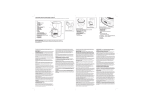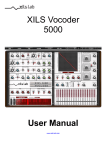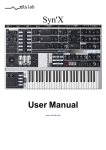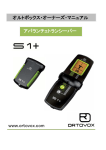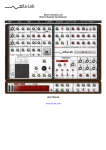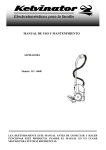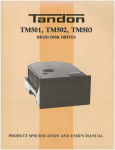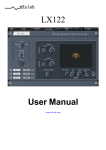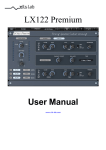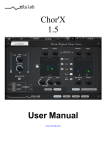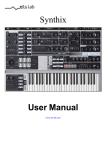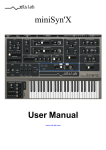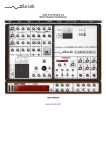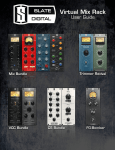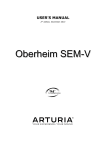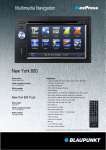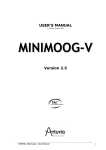Download XILS V+ User Manual - XILS-lab
Transcript
XILS V+ User Manual www.xils-lab.com Table of contents 1 INTRODUCTION................................................................................................................................................3 2 FEATURES.......................................................................................................................................................... 4 3 INSTALLATION................................................................................................................................................. 5 3.1 ELICENSER DRIVERS............................................................................................................................................. 5 3.1.1 If you already own a eLicenser ............................................................................................................... 5 3.1.2 If you have received a eLicenser dongle from XILS-lab .......................................................................... 5 3.2 ILOK DRIVERS .................................................................................................................................................... 5 3.3 WINDOWS (XP, VISTA, WINDOWS 7)................................................................................................................. 5 3.4 MAC (OSX 10.4 AND LATER).............................................................................................................................. 7 4 USING THE XILS V+......................................................................................................................................... 8 4.1 INTRODUCTION.................................................................................................................................................... 8 4.2 USING THE XILS V+ TOOLS BAR..........................................................................................................................8 4.3 ADJUSTING THE INSTRUMENTS PARAMETERS..............................................................................................................8 4.4 USING THE XILS V+ AS AN INSTRUMENT.............................................................................................................. 9 4.4.1 The Strings............................................................................................................................................... 9 4.4.2 The Human Voice................................................................................................................................... 11 4.5 USING THE XILS V+ AS AN EFFECT: THE VOCODER............................................................................................. 12 4.5.1 The XILS V+ as a simple effect............................................................................................................. 12 4.5.2 The XILS V+ as a Midi Controlled effect.............................................................................................. 14 4.5.3 The XILS V+ Vocoder Advance settings panel...................................................................................... 14 4.6 THE EFFECTS ADVANCED SETTINGS PANEL ............................................................................................................ 16 4.6.1 How the XILS V+ are routed................................................................................................................. 16 4.6.2 The Phaser............................................................................................................................................. 16 4.6.3 The Stereo Space....................................................................................................................................17 4.6.4 The Reverb............................................................................................................................................. 17 4.7 THE MODULATION ADVANCED SETTINGS PANEL ..................................................................................................... 18 4.8 KEYBOARD ARPEGGIATOR ................................................................................................................................... 19 4.9 PITCH AND GLIDE FUNCTION .............................................................................................................................. 20 5 PRESET MANAGEMENT............................................................................................................................... 21 5.1 MAIN TOOLBAR................................................................................................................................................ 21 5.2 PRESET MENU................................................................................................................................................... 21 5.3 SORT MENUS..................................................................................................................................................... 23 5.3.1 Sorting Menu: Additional Functions .................................................................................................... 24 5.4 A/B COMPARISON.............................................................................................................................................. 25 6 OPTION MENU.................................................................................................................................................25 6.1.1 Main....................................................................................................................................................... 25 6.1.2 Display................................................................................................................................................... 25 6.1.3 Misc....................................................................................................................................................... 26 7 SPECIAL TIPS................................................................................................................................................... 27 7.1.1 CPU-Load..............................................................................................................................................27 7.1.2 Performance-Tips.................................................................................................................................. 27 8 CREDITS............................................................................................................................................................ 29 1 Introduction Thank you for choosing the XILS V+! The XILS V+ is a virtual instrument based on the architecture of one of the one of the coolest vintage instruments out there. Strings and voice machine, but also vocoder, the XILS V+ can bring you back some years ago when sound was so important for the great artists who began the electronic music. But the XILS V+ is giving much more than a string machine, much more than a Vocoder or Human Voices chords. Thanks to its huge modulation possibilities and despite some but musical limitation brought by the Top Octave Divider oscillator (see below), it is a full-featured synthesizer while keeping the character of the original machine. We at XILS-lab do our best to create authentic recreations of the great synthesizers we emulate and then take it even further. What can be done with today’s computers allows us to take these emulations beyond what was feasible when these products were first created. Our goal is to be true to the original in sound and modulation routings and then add features that were just not before possible. If you not yet developed your skills as a sound designer, we have included a lot of presets from famous sound designers and artists. So you can fuel your synthesizer or robot voices dreams as soon as you load the XILS V+ into your DAW. Please enjoy this very powerful sound creation tool. We love what we do and we want you to get the most enjoyment you possibly can from our labors. We want to hear from you. So “like” us on Facebook http://www.facebook.com/XILSLabs and join in the conversation 2 Features The XILS V+ offers: • • • • • • • • • • • • • One finely tweaked and emulated Top Octave Divider oscillator, providing up to 49 voices of polyphony. One string. One human voices section. One 10 bands filter vocoder. A virtual keyboard, which can be saved in your presets. An Advance Stereo Space effect. A simple but nice sounding reverb. Analog-like resonant phaser. Up to 6 free assignable modulation dots, with up to 14 sources and 24 destinations A special Glide function. A finely tweak analog-like pitch tracker. Access to a lot of parameters which were not accessible in the hardware version All parameters are MIDI controllable The XILS V+ is available in the following formats: • • Mac OSX 10.5 and later: VST, Audio Unit, RTAS (Pro Tools 7.0 and later), AAX Windows 7, XP and Vista: VST, RTAS (Pro Tools 7.0 and later), AAX AAX Minimum system requirements: 1 Gigabyte of RAM and a 2 GHz processor. The XILS V+ is a plug-in and is not available as a standalone application Notice: The screen resolution must be set at least to 1024 pixels width. 3 Installation XILS-Lab offers you the choice of using eLicense or iLok. This first section describes the process for authorization for eLicense. eLicenser drivers 3.1 The XILS V+ uses an eLicenser dongle. You must have this dongle connected to a USB port on your computer to make the XILS V+ work. Important : Please take care of your dongle: you need it to run the XILS V+ and it carries your license! 3.1.1 If you already own a eLicenser Please Note: Even if you have already installed the eLicenser drivers for a previous product, please install the latest version of the eLicenser License Control. To download the latest eLicenser Control Center (eLC), please go to: http://www.elicenser.net/en/latest_downloads.html You need a XILS V+ Activation Code to load your license onto the dongle: First, plug your dongle into a USB port of your computer. Then launch the License Control Center. Launch the Enter authorization code. Enter your Activation Code in the reserved field, and press Next. Wait for the license to be downloaded and then check to see if the license is correctly loaded on the dongle in the main section of the License Control Center. 3.1.2 If you have received a eLicenser dongle from XILS-lab You must first install the eLicenser drivers (eLicenser Control Center, eLC). To download the latest eLC please go to: http://www.elicenser.net/en/latest_downloads.html Then plug your dongle into any free USB port on your computer. Then launch the License Control Center and enter the authorization code you received as explained above. 3.2 iLok drivers With the iLok version of the XILS V+, you need to plug an iLok USB key into your computer. After downloading and installing the latest PACE drivers, please login into you ilok.com account to download your XILS V+ license into your iLok USB key (you may need to redeem the license, using your license code you received: follow “redeem license code” on your ilok.com account) To download the latest PACE drivers, please go to: http://www.ilok.com/download-ilok-software.html 3.3 Windows (XP, VISTA, Windows 7) To install the XILS V+ on Windows XP, Vista or Windows 7, launch the XILS V+ installer file Please download the latest version from the XILS-lab website. http://www.xils-lab.com/pages/XILS V+_Download-Installer.html Once you have accepted the license agreement, you will be asked to select the components to be installed : 32 bits windows XP : 64 bits windows (Vista, 7 or 8) : You can choose which format to be installed between RTAS, AAX, VST2.4 (32 and 64 bits) and VST3 (of course you can install of them). Then you will be asked to select various install directories. A destination directory is provided as a default. Presets and various files, like this manual, used by the XILS V+ will be stored in this directory. Please note that this location is different from the VST install directory, which you will need to specify in the next step of the installer. Once the installation directory is specified, you will be asked to select the VST plug-in directory, with a suggested default location. Make sure that the path for the 32 bits plug-in differs than for the 64 bits plug-in (as the default path does) Important notice for Vista or Windows 7: be sure to use a folder write enable and owned by the user (do not use “c:/program files” for instance). Otherwise you will have to run your music application with “administrator rights”. The RTAS plug-in and its table control management Pro-Tools are directly copied into the following directory: C:\Program Files\Common Files\Digidesign\DAE\Plug-Ins 3.4 Mac (OSX 10.4 and later) To install the XILS V+ on a computer equipped with Mac OSX 10.5 or later, download the latest version of either the iLok or eLicensor versions from the XILS-lab website to make sure you have the latest version of the software. http://www.xils-lab.com/pages/XILS V+_Download-Installer.html Then launch the install program, XILS V+. pkg, and follow the instructions. Warning: the install program will ask you for your system password. Just after selecting the drive where the XILS V+ will be installed, you can choose which components to be copied by clicking on “customize” and selecting or unselecting them : The various files of the XILS V+ will be copied into the following directories: Library/Application Support/XILS-lab/XILS V+ Library/Application Support/Digidesign/Plug-Ins Library/Application Support/Avid/Audio/Plug-Ins Library/Audio/Plug-Ins/Components Library/Audio/Plug-Ins/VST Library/Audio/Plug-Ins/VST3 Library/Application Support/Documentation/XILS-lab/XILS V+ And for the user preset and various option : ..users/username/Library/Preferences/XILS-lab/XILS V+ 4 Using the XILS V+ Introduction 4.1 The XILS V+ can be used as a simple effect, as an instrument or as a Midi controlled plug-in. Depending on your DAW, you may have to choose the correct plug-in (XILS V+ for the effect or Midi controlled plug-in, or XILS V+ Inst. For an instrument) Using the XILS V+ tools bar 4.2 Note: The toolbar at the top of the interface allows you to load or save presets, make a comparison between settings A and B, or modify the options. These functions are described in detail later in this manual. Click on the PRESET arrow to show the available presets in the current sorted group. Please note that selecting a new preset without saving your current settings will erase any changes you have made to those settings. Click on the sort arrow button to display the current sorted group and to choose the preset within it. You can sort presets by: Author, Feeling, Type, Style, Bank or Projects. Please note that the XILS V+ will display presets by instruments categories (Type) by default. Click on the sorting label over the sorted group name, to sort your preset according to your preferences. Please note that the XILS V+’s powerful Preset management is fully detailed in chapter 6 of this manual. Adjusting the instruments parameters 4.3 On the XILS V+, the sound parameters are controlled using faders, knobs or switches To adjust with the mouse, the parameters of the XILS V+ which are controlled by faders, click on the slider of the fader and drag it up to increase the value, of drag it down to decrease it. To adjust with the mouse, the parameters of the XILS V+ which are controlled by knobs, click inside it and move the move up or right to increase the value, down or left to decrease it. If you right-click on a parameter, or if you hold shift while clicking, you can adjust the parameter with fine precision (the ? button of the toolbar displays a panel summarizing these shortcuts). Keyboard shortcuts In addition we have provided some soft keys combination to perform several very useful tasks: Windows: • • • CTRL+left click: reset parameter to its default value. CTRL+right click or CTRL+Shift+left click: initialize the default value of the parameter. Win+Alt+CTRL + click: open the MIDI Control panel, with the parameter already selected. OSX: • • • Apple+left click: reset parameter to its default value. Apple+Shift+left click: initialise the default value of the parameter Apple+Alt+CTRL + click: open the MIDI Control panel, with the parameter already selected. Note: Other GUI elements and controls, like the LED Switches, or the drop down menus, will be described in the following sections of this manual, when you’ll need to use them. The switches are simpler: just left click to change their state. A right click will change the state only while the button is pressed, and return to the previous state when it is released. When a parameter is chosen via a drop down menu, just click on the button or label and select the item. Using the XILS V+ as an instrument 4.4 The XILS V+ instrument is a wonderful string machine as well as an amazing and specifically well Human Voice chords generation. Inserting the XILS V+ Inst or the XILS V+ in your Instrument track will allow you to use these two features. Note: On Logic Pro, this is also the way to use it as an Midi controlled effect hence using the build-in vocoder (see below), but on other major DAWs, this will forbid to use the vocoder, for no sound will be input in the vocoder filters. 4.4.1 The Strings Once the XILS V+ is launched, an init preset “Simple Strings” is selected, you can immediately play with. The Strings level can be adapted thanks to the “strings” fader in the “balance” section or to the “Master level” knob. Note: the “strings” fader increases the level of the strings before the ensemble. This means that with high level, the ensemble internal compressor and bucket brigade delays begin to reach some non-linearity, affecting the sound (especially low rumble for some chords due to the compressor and the Top Octave Divider architecture). On the contrary, the “Master level” is totally linear and is applied at the very end of the audio path. The keyboard is split in upper and lower part and using the two green rocker switches, you can enable the strings for the lower or the upper part. This “Simple Strings” preset is using only the string generation; hence if the “lower” green rocket switch is off, then no sound will be generated when a note of the lower part is played. On the left of these two rocket switches, you will find two faders “Attack” and “Tone” which respectively set the Attack time of the strings and its high frequency characters. The “Simple Strings” preset mimic the Strings features of the Hardware model. This means that the Strings attack is not polyphonic: The first note played is triggering the attack envelope, but the other notes are output with the same current level. Playing chords is not affected by this behaviour but playing arpeggio with sustain notes could be less than musical. That's why the XILS V+ added a new feature hardware would find difficult to do: Just above the String Attack fader, when the “Arp/Mixer” panel is displayed (orange rocket switch, see below), you will find a white rocket switch labelled “poly”. When ON, this switch enable the real polyphonic attack virtual circuitry, allowing real polyphonic attack behaviour. Note: The monophonic mode is working better (no clicks) when the Release Legacy mode is engaged (see below) At the right of this rocket switch, you will find two faders, “Filter” and “Ens Dry/Wet”. These faders allow the user to have access to two internal parameters the original model kept secret. With “Filter” you can change the Strings filters shape while with “Ens. Dry/Wet”, you can set the level of the Ensemble effect (see below) which is always full wet on the hardware. At the left of the Strings parameter group, you will find a “Release” fader. This fader set the release time which is fully polyphonic (up to the maximum 49 available voices of the XILS V+) but as the Original hardware model, directly applies on the Top Octave Divider oscillators, then shared with all the synthesis generation of the XILS V+ (meaning shared with the Strings, Human voices and Vocoder carrier) Above the “release” fader, you will find two other parameters available for the user. As the release, these parameters are applied on the Top Octave Divider oscillator, hence global for the Strings, Human voices or Vocoder carrier. The rocker switch “Legacy”, when on, allows the original hardware behaviour for the release: Each time the keyboard is empty; a new note will stop the current released sound. When on, the release of each note are kept running whatever the keyboard state. The fader “Wave FRM” allows modulating the oscillator waveform for the Strings and the Human voices (not for the Vocoder Carrier) 4.4.2 The Human Voice Once the XILS V+ is launched, select the following preset: Bank: Factory, Author: XILS-lab, Preset: Male 8 You can immediately enjoy the well know chords of male Human voices. As for the strings, the Human voice level can be adapted thanks to the “Human Voice” fader in the “balance” section or to the “Master level” knob. This “Simple Voice8” preset is using only the Human Voice generation, hence if the “lower” with rocket switch “Male8” is Off, then no sound will be generated when a note of the lower part is played. Switch ON the “Male4” rocker switch for the “Lower” part of the keyboard, a new voice, one octave above is generated. Switch ON the “Female4” rocket switch for the “Upper” part of the keyboard, a new voice, with female texture, one octave above is generated. The fader “Attack” similar as the one you found in the string section, allows you to increase of decrease the attack time when a note is played. And similar to the strings, When the rocket switch “Poly”, found in the “Arp Mixer” panel (see below), just above the “Attack” fader, is ON, then the attack circuitry is polyphonic, otherwise, it is paraphonic, meaning that only the first note played on the keyboard will trig it. The other played note will be generated at the current level reach by the first note. Note: The monophonic mode is working better (no clicks) when the Release Legacy mode is engaged (see above) Switch ON the grey rocket switch “Ensemble” allows the human voices to enter the “Ensemble” circuitry, giving a wide, warm and analogy like vintage chorus effect. At this time, the various voices can be ON or OFF, but we opened the mix parameters to the user. Above these rocket switches, in the “ARP Mixer” panel, you will find two mixer faders, “MALE 8” and “ML/FM 4” These two faders are setting respectively the level of the “Male 8” voices (“Upper” and “Lower”) and the level of the “Male 4” (“Lower”) and “Female 4” (“Upper”) voices. Note: When the fader is set to zero, then no sound is generated for the corresponding voice, whatever the position of the rocker switch. This is obvious but can be sure of wondering when switching ON one of the Human voice switches and getting no sound because of this level parameter. Near these two faders, you will find three other faders, available for the user and opening an internal function, kept under the roof on the original hardware. The “Dry/Wet” fader increases or decreases the effect of the ensemble in a similar way the Strings's one. Of course, this effect is noticeable only when the grey rocket switch “Ensemble” is ON. The “Frmt Res” fader allows the user to increase of decrease the resonance (emphasis) of the Human voices formant filter, making the vowel more or less distinctive. The “Frmt Shift” fader allows the user to shift the formant frequency, changing the way the vowel sounds. The Human voices (as well as the vocoder output we will see later), before being sent to the ensemble effect, are processed by a vibrato effect. The “Rate” fader sets the frequency of this vibrato, the “Depth” fader, the amount and the “Delay Time”, the delay time between the first note play to the keyboard and the beginning of the effect. Using the XILS V+ as an effect: The Vocoder 4.5 The XILS V+ features a 10-band filters vocoder (which can use at the same time than the other sound generators for wonderful textures and sounds). Launching the XILS V+ to be used as a vocoder depends on your DAW as the way the way the provide midi messages and audio input differs. 4.5.1 The XILS V+ as a simple effect This is the easiest way to use the XILS V+, as a vocoder is when chords or notes are not going to be changed. For this you just have to insert your XILS V+ in an audio track, mixer or effect rack (it can be used as an insert or a send effect). Once the XILS V+ is launched, select the following preset: Bank: Factory, Author: XILS-lab, Preset: Simple VocoderC1 As you can see, the note C1 is held (it was right clicked then saved in the preset, see below) Then start your DAW, your audio content should be input the XILS V+ and modulating the carrier done with the Top Octave Divider oscillator trigged by the note C1: a typical Robot vocoded sound. Make sure audio is correctly sent to the XILS V+ by looking at the two LEDS (green and red) at the right of the Vocoder level. When the red lights, then audio is almost at the maximum level, beginning to enter to some no-linear effects. The vocoder level can be adapted thanks to the “Voc. Level” fader in the “Vocoder” section or to the “Master level” knob. It has to be noticed that the overall level of the vocoding sound depends on the Carrier level (set by the “Voc. Level” fader”) but also on the audio content fed to the vocoder. Switching On or Off the red rocket switches “Lower” or “Upper”, allows the vocoder to be affected to the Lower, the upper of both parts of the keyboards. When using the XILS V+ as a Midi controlled Effect (see below) you can get a vocoding sound on the upper part while a bass line or chords are played in the lower part. Switching On the grey rocket switch “Ensemble” allows the vocoding sound to be treated by the “Ensemble” effect, the same which process the Human voice or the Strings. In the same way we did for the Strings or the Human Voice, a “Dry Wet” fader, just above this rocket switch in the “Arp Mixer” panel, allows to reduce the effect of the ensemble on the vocoding sound. To listen the unaffected audio content, rise the “Direct Mic” fader in the “Balance” section. The “Flt Dir” fader is setting the level of the high pass filtered direct mic signal: The more you raise it, the more some consonances are noticeable, making the vocoding voice more understandable. See below the “Vocoder” panel related chapter to get more parameters for the Vocoder. The Vocoding sound, as the Human voices, are processed by a “Tremolo” effect which uses the same settings for the both (see above, in the Human voice related section, for an explanation of the “Tremolo” parameters) To change the note of this Vocoding sound, click on the C1 note, this will released it. Of course no sound is then created by the Vocoder. Click on an other note, a sound is output, but stops as soon as the note is released. To hold the note, just right click on it instead of left click. You can add any number of notes doing this. Using the “Save as” button, the “save” button (see the preset management chapter below), this new chord can be recorded in a new preset. 4.5.2 The XILS V+ as a Midi Controlled effect A robot voice is interesting, but we may want to change the note or the chords; for this, Midi messages must be sent to the XILS V+. They way it is done depends on the DAW. You will find below two examples, one for DAW that are working like Logic 9 and an other which are working like Cubase Several other examples, for several different DAW, are explained at the end of this manual. Logic needs the XILS V+ to be inserted in an instrument track. Be careful to insert the Midi controlled effect, not the instrument only plug-in. Once the XILS V+ is launched, you will find a side chain menu, created by the DAW. You just have to select the audio track to feed audio content to the XILS V+. Each Midi notes are also sent to the XILS V+ and driving the Virtual Keyboard. Cubase needs the XILS V+ to be inserted as an effect (either insert or sent). Create then a Midi track and select the XILS V+ in the list of the instruments where which the midi message are sent. You can use now your XILS V+ vocoder in the same way explained in the above chapter, excepted that you can change the note or the chords the way you like. 4.5.3 The XILS V+ Vocoder Advance settings panel We already presented a part of the “Arp Mixer” advance settings panel, which is opened by default, but three other panels are available, opening thanks to the orange rocket switches below For opening the Vocoder dedicated panel, just click on the “Vocoder” orange rocket switch. In this panel, you can see 4 sections, “Filters”, “Analyse”, “Side Chain selection” and “Pitch Tracking”. The section “Filters” allows you to change two important internal parameters, the consonant frequency and the filter band emphasis. The first parameter, set by the “Cons. Freq” fader, change the cutoff frequency of the high pass filter with processes the direct mic audio before mixing it to the vocoding sound at the level set by the “ Flt Dir” fader (see chapter above). This way, you can keep noticeable consonance without getting too much of the voiced signal. The second parameter, set by the “Qual” fader, changes the emphasis of the various filters of the vocoder. This allows you to have a more or less understandable voice as well as a more or less filtering resonance effect. The section “Analyse” allows you to set some of the vocoder analysis parameters. The “Att” and the “Rel” faders are setting respectively the attack time and the release time of the envelope follower circuit, which finely follow the level of the input audio in each of the 10, analysis filters. Set the “Att” fader at the minimum to have a sharp and reactive effect or to the maximum if you want the sound to follow very slowly the audio input. Set the “Rel” fader to the maximum if you need the spectrum to be sustained for a very long time, or to the minimum for a very articulated voice. The white “Freeze” rocket switch (Midi controllable) allows you to freeze the spectrum of the audio input. This spectrum can be save within the preset or project. The white “Water” rocket switch enable the “water” effect. This effect mimics a voice spoken in the water. The section “Side Chain selection”, as it name says, allows you to select from which input the direct mic audio is coming. See the section “Using the XILS V+ with a side chain” for more information. In a standard effect use, the rocker switch must be set to “Mic: INPUT” The section “Pitch Tracker” allows you to tweak the analog-like pitch tracker To enable the pitch track, you must connect it to the pitch of the Top Octave Divider oscillator by setting the three positions selector to the “P. Track” position. In this position, the detected pitch of the input audio content modulates the pitch of the oscillator. In the “pitch tracker” section, the “Qual” fader sets how the detected pitch is stable or not. The lower, the more random (with octave detection errors) the pitch becomes, the higher, the less evolving pitch. The “Zero” fader adjust an offset to the pitch allowing you to tune the melody without changing the global tune of your XILS V+; The “Range” selector has the same effect. “Low” and “High” frequency faders set two limits in the detection. This helps to avoid octave detection errors and allow a better pitch following without too much artefacts. And lastly, when the white “Snap” rocker switch is ON, the detected pitch is snapped to the standard midi notes frequencies. Pitch tracker works very nicely when using the XILS V+ vocoder, but can also be used to modulate the pitch of the Strings and the Human voices. It is also one of modulation source (see below, the modulation related chapter) The Effects Advanced settings panel 4.6 By clicking on the orange “Effects” rocker switch, you are opening the effects advanced settings panel where you will find the must have phase for any strings machine, a Stereo space, based on our well known True Stereo Dynamic Engine, as well as a simple but warn and nice sounding reverb. To enable the Phaser, the Stereo Space effect or the Reverb, you first much switch ON their corresponding red rocker switch. 4.6.1 How the XILS V+ are routed When the Stereo Space is disable, the Phaser is processing the output of the end mix of the XILS V+, where every dry signals and Ensemble wet signal are mixed up together. The output of the phaser can then eventually be processed by the Reverb. On the contrary, for an easier user management, when the stereo space is enabled, the phaser is only processing the Ensemble output. In the same way, when the Stereo space is enable, the reverb inputs are taken from the internal reflexions of the Space algorithms, otherwise the reverb is processing output of the XILS V+, after the build-in original Ensemble and the Phaser if enable. 4.6.2 The Phaser The phaser is a finely emulation of an analog phaser, providing all its internal parameters to allow a wide range of sounds. The “dry/wet” fader is increasing or decreasing the effect while the “Speed” fader increase or decrease the speed of the modulation. To increase or decrease the mount of the modulation (the width of the frequency sweep) just adjust the “AMNT” parameter. The “Sweep” parameter allows the frequency around which the modulation occurs to be set. And the “Stereo” set the differences between the left and the right channel. Lastly, the “Res” parameter set the level of the internal feedback, allowing increasing or decreasing the level of the harmonics swept by the phaser. 4.6.3 The Stereo Space Once the Stereo Space is enabled up to six dots are displayed: • Green: Dry Strings (the strings before to be send to the Ensemble effect) • White: Dry Human voices (the human voices before to be send to the Ensemble effect) • Red: Dry vocoder • Grey1: Left Ensemble output (eventually processed by the phaser) • Grey2: Right Ensemble output (eventually processed by the phaser) • Blue: Direct Mic input A dot is displayed only when the corresponding generator is enabled or has a not null level (for instance, if the “Direct Mic” fader is set to zero, the corresponding dot won't be displayed). Each dot can be moved in the 2-D, left or right but also far or close, related to the microphone position. These latters can also be moved and their angle changed with the “Mic Angle” fader. The “Width” allows to sense of space to be changed, from a tiny to huge. Three faders are also providing to adjust the level of the dry/wet of the Ensemble input. These faders are the same than you can find on the “Arp Mixer” panel but double them here allows you to tweak them without having to change the displayed panel. 4.6.4 The Reverb The reverb has three algorithms (“Large”, “Medium” and “Small”), which can be chose thanks to the three-position selector ”Type”. The reverb time can be adjusted with the “Time” fader; the level of the reverb with the “Level” fader and lastly, the “Lpass” adjusts a high frequencies release. The Modulation Advanced settings panel 4.7 By clicking on the orange “Mod” rocker switch, you are opening the Modulation advanced settings panel where you will find, dedicated to the modulations, an envelope, an LFO and up to 6 modulation nodes. The LFO rate is adjust with the “Rate” fader. Clicking on the led close to the label enable the MIDI synchronization. Switch ON one or several white rocker switch enable the corresponding waveform. The envelope has the standard settings, a “delay” (Midi synced when the led is clicked) to adjust the time between the trig and the effect, an “attack” fader to adjust how fast the effect fade in, a “decay” fader, a sustain fader to adjust the level of the envelope during the time the note is held, and lastly a “release” fader to adjust how fast the envelope return to zero. For each of the 6 modulation nodes, you can chose the source by clicking in the source display, the destination, by clicking in the destination display and the amount of the modulation by turning the knob. The modulation sources and destinations are grouped in Monophonic and Polyphonic behaviour. A monophonic source can modulate both monophonic and polyphonic destination. A Polyphonic source can only modulate a Polyphonic destination. A Monophonic destination can be only modulated by a Monophonic source. So depending on the cases, some choices are enable or not Monophonic sources: Polyphonic sources: Monophonic destinations: Polyphonic destinations: These modulations possibilities offer a wide range of new sounds the original hardware model can't achieve. From tiny changes for giving more vibe to huge effects, the XILS V+ sounds possibilities are far away from those you can find in a simple string machine or vocoder. Keyboard arpeggiator 4.8 The XILS V+ provides a simple but powerful arpeggio. To have access to its settings, click on the orange “Arp Mixer” rocket switch. When ON, this module reads the note hold on the keyboard and instead of playing them at the same time, it will play each note after the other. There are three modes available: Up, the notes are played from the lower to the higher. Down, the note are played from the higher to the lower and Up/Down for which they are played backward and forward. If none of these there modes are selected, then the notes are played in a random order. The cycle can also play through other octaves before restarting when the Oct switch is selected. Selecting the Polyphonic mode allows chord to be played according to a specific sequence, modified easily by the user. ON: enable or disable the arpeggiator POLY: enable the polyphonic mode UP: play notes ascending mode DOWN: play notes descending mode SWING: set a swing value to the arpeggio. Turn right to get no swing, turn left to get maximum swing. A 66% value gives you typical jazz swing. GATE: set the time a note (or a chord) is held by the arpeggiator, from zero to the clock period. RATE: set the clock frequency of the arpeggio MIDI Sync LED: close to the RATE, a switchable LED synchronizes the clock rate to the application host tempo. The three positions “Nbr Oct” selection allows setting the number of octaves involved in the cycle and the “Broken Arp” three-position selection allows enabling the broken arpeggio mode. This mode, instead of playing the note of the chords in a simple cycle, CEGB for instance if a CEGB chord is held, will play either CEGEGBGBC or CEGBEGB depending on the choice. Clicking in the first text display allows you to change the Arpeggio mode. When a new note is played, “Free” updates the arpeggiator immediately, but you can choose also “After Each Note” or “After Each Cycle”. Clicking in the second text display allows you to enter a chord sequence used in the polyphonic mode (“Poly” rocker switch). The chord sequences transposition played in polyphonic mode can be edited there. Each number, from 0 to 12 stands for the base of the chord, and must be separated by a space, comma or semi-colon. Up to 32 numbers can be entered. Pitch and Glide function 4.9 The XILS V+, as his ancestor, provides a special glide function. The “Pitch Shift” slider modulates when the three positions selector is set to “Manual” the pitch of the Top Octave Divider oscillator. This has the same behaviour as a standard pitch bend. The “Pitch Set” knob adjusts the amount of the pitch modulation. The three positions “Range” selector allows choosing the octave, while the “Tune” knob adjusts finely the tune of our XILS V+ When the three positions selector is set to “P. Track” the pitch of the Top Octave Divider is modulated by the pitch tracker (see Vocoder settings above), and when it is set to “Glide”, then it is modulated by the glide function. The amount of this later modulation is still adjusted by the “Pitch Set” knob while the time of the glide, the time the pitch will take to reach its final value, is adjusted by the “Time” knob, from “Short” to “Long”. The glide function is a Monophonic feature. This means that it is trigged by the first note played on the keyboard and note by the note played after, and this until no not are played. The “Modulation” slider is a simple modulation wheel (directly connected to the MIDI mod. Wheel) to be used through the modulation possibilities of the XILS V+. 5 Preset Management 5.1 Main Toolbar In the toolbar you can find two buttons, displaying the category name (Bank, Author, Type, Style, Feeling or Project), which open the sort management menus. The two first text fields show the current sorting group and the third shows the current preset. Clicking on the arrow on the left of the category or preset names opens the corresponding menus. Note: When a parameter is modified, the name of the preset is followed by a *, indicating that the current settings of the XILS V+ no longer matches the stored preset. When you want to save a modified preset, click on the Save or Save As button. In order to prevent you from erasing them, the Factory presets cannot be modified. When you edit a Factory preset, the Save button will be grayed, and you will have to use the Save As function to save it in another bank. If you edit any other preset than a Factory one, the Save and Save As function will both be available. The main difference is that the Save function will save the preset under its current name, and with its current tags, overwriting the previous incarnation of the preset, while the Save as function opens a dialog box where you can modify the name of the preset, the bank in which it will be stored, and all its tags The settings of the XILS V+ are then saved in the currently displayed preset, and the * disappears. Click on the Save As button to save this preset with another name and/or to other sorting groups. 5.2 Preset menu Click the Preset arrow button to open the preset menu. Here you can choose and load another preset from the current sort groups into the XILS V+. In this menu, other actions are also available: Delete Preset: use this to delete the current preset (a popup confirmation window appears). This option is only available if the current preset is not a factory one. Export Preset: Use this function to export the current preset in an external file (.epsx format). This file can be imported later as a new bank. It always makes sense to back up your presets on external media. Open preset Information (or click on SAVE AS): opens the following preset information window where the name and all other information related to the current preset can be displayed or changed. In this window you can modify the Name of the preset, specify the Bank in which the preset will be saved, and also enter information in the other fields: • • • • • AUTHOR (Your name, mostly used by Sound Designers for factory presets), Type (Category of the instrument like Keys, Leads, Basses, also) Style (Musical Genre), Feeling (Cold, warm, soft) and finally Project (My Song, My_Live_Project). You can also see its creation date and the last update date. To modify a preset name, click in the preset field and enter the new preset name this will also save all the current settings. To change presets information, click on the display, this will open a menu when you can select one of the existing items. Note: You can add a new item in any category, and therefore create custom banks, custom styles, Projects, categories of instruments etc. To add a new item in any filed, select “New….”. Which appears at the bottom of the list. Note (You may have to browse until the end of the list in order to select “new” depending on its length.) A Pop Up window opens when you can enter the new name. The current preset will then be associated to this new item. Note: Please be aware that creating to many categories can also have its drawbacks, making browsing go from difficult and painful to nearly impossible. Should you create around 200 different custom instrument categories, it would become very difficult to browse the library using the Style sorting. Once you have filled all the desired/required fields: SAVE AS: Will save the current preset in the chosen Bank, with its new (or unchanged) Name, and tagged with all the fields you filled in. MOVE TO: Allows saving the current preset in another location. This is handy to gather a lot of preset into a single location, or User Bank, which you can export in a single file containing all the presets you created or edited for a given project. CANCEL: Will just cancel all operations and return to the standard XILS V+ GUI. Sort menus 5.3 The sorting menus are unique and a powerful tool. Allowing you to perform sophisticated tasks, such as displaying the preset list organized in a variety of different ways: • • • • • All the Basses of your Sound Library All the Basses tagged with a given musical genre All the Pads made by a given Sound Designers All instruments for a musical genre like Electronica, or Funk All instruments that were recently imported in a bank (like additional sound-sets from Xils-Lab or 3 rd party vendors) There are indeed a lot of possibilities, and we’re confident that you’ll find the best way to customize it to your personal needs. In order to perform such selections, all you have to do is to select an item in the first sort menu. This represents the first and main criteria for the search engine. • • • • • • AUTHOR (Your name, or a Sound Designer name for factory presets), Type (Category of the instrument like Keys, Leads, Basses, etc) Style (Musical Genre), Feeling (Cold, warm, soft) and finally Project (My Song, My_Live_Project). ALL (this item is not used for sorting the preset) These primary results can then also be filtered according to second criteria. Which can be chosen from a similar list in the secondary sort menu. Sometimes a picture is better than a lot of text, so you’ll find below an example where you can find out how to select all the basses designed by a given Sound Designer. Please note that, once you are familiar with this system, you can also perform some operations in a single click, by using the Sub Groups to choose a preset: In the picture below the primary sort menu is used to browse the different banks. Then in a factory bank, the author Xils-Lab is selected, and finally the Preset XO Bass. In this example the preset is selected in a single click operation, and the presets available in the preset list will be all the Xils-Lab presets available in the entire Factory Sound Library. Click on the row of the sorting button to open the menu used to manage this sorting group (or sub group). Here you can directly select and load any preset from any group or subgroup. 5.3.1 Sorting Menu: Additional Functions In this menu, other actions are also available: Delete: deletes all of the presets of the current group that are not factory ones. IMPORTANT: Use this function with care: If the bank does not contain any factory presets, ALL PRESETS IN THIS BANK WILL BE PERMANENTLY DELETED. Rename: modifies the current group name. Selecting this choice will open a window where the new name will be entered. Use Factory: enables or disables the display of factory presets. Sort By: This function sorts the presets according to bank, author, project, or shows all presets (Bank Name, Author Name, Project Name, All Presets). The preset menu will show presets of the same category (same author, same project or same bank). Export Bank: This function exports a bank in the XILS V+’s proprietary cross platform format, (Mac and PC). The selected bank (i.e. the bank which contains the currently active preset) will be exported to a user specified location on your hard drive. Import Bank: This Function allows you to browse your hard drives to select a file and imports a XILS V+ bank. These two choices are not available from the second sort menu. This menu provides also the possibility to change the size of the interface. This feature is the same that the one provided in the Option menu. 5.4 A/B comparison You can store two different settings at the same time and instantly switch from one to the other to compare their settings. These two settings are stored in the A and B memories. When you launch the XILS V+, the default-activated memory is A. When you load or modify a preset, this memory –A- is also modified in real time according to your edits. You can switch to B memory by clicking on the B button. To copy the current active memory content to the other memory slot, just press the button labeled -> or <-, according to the current active memory. With this A/B comparison system, you can easily have two settings and compare them in a convenient way. Note: Please note that by default, the B memory slot, until you copy settings into it or until loading a other preset within the other memory slot, contains the same init patch loaded in the A memory when you first launch the XILS V+. 6 Option menu This menu allows to choosing the global settings. These settings are defined for all the instances of the XILS V+. Each time an option is changed, the related option file is saved. 6.1.1 Main In the toolbar, the Options button opens a menu for selecting various options for the XILS V+. This menu shows the following options settings: XILS V+ About: displays information about the XILS V+ (version, build date and credits). Open MIDI settings panel: Opens a popup where you can assign MIDI controllers for each of the XILS V+’s parameters. Click on the parameter label to select the parameter you want assign, then enter the MIDI controller number (from 0 to 127), or switch on the learning switch and send a MIDI command with the correct MIDI controller number. The XILS V+ will memorize it. This setting popup can also be opened by CTRL+ALT+Apple+Left-click (Mac) or CTRL+Win+ALT+Left-click (Win) on the desired XILS V+ parameter. 6.1.2 Display Display low frequency as BPM: Allows displaying the low frequency (LFO, oscillator 2 in low mode, clock rate in BPM instead of Hz) GUI follows presets: When checked, this option allows the GUI to follow the presets. That means that the special display modules are refreshed following the preset settings. Otherwise it keeps the same view. Output level follows presets: When checked, this option allows the output level to follow the presets. That means that the output level is programmed with the value saved in the preset. Otherwise it keeps its value. Popup On: shows a popup window while modifying the value of a knob. Popup Over On: shows a popup window when the mouse is over a switch. Popup Name On: the name of the current modified parameter is displayed. GUI update: low: slow refresh rate for the GUI. Useful when it is necessary to save CPU power. GUI update: middle: standard refresh rate for GUI. GUI update: fast: fast refresh rate for GUI. Useful when it is necessary to precisely follow the sequencer's led for instance. 1000p width: select the 1000p width GUI (relaunch needed) 1200p width: select the 1200p width GUI (relaunch needed) 1400p width: select the 1400p width GUI (relaunch needed) 6.1.3 Misc Init settings from current settings: initializes the default values of the XILS V+ from the current settings. All the new presets will be created from these settings, when the init settings choice is selected. These parameters will also be used when setting a control to its default value. (Win: CTRL+click, OSX: ALT+Apple+Click). Layer locked when loaded: When this option is checked, the layer is locked (not writeable) when a multi-later is loaded. Wheel Incr: 0.01: parameter increment of 0.01 when using of the mouse wheel. Wheel Incr: 0.05: parameter increment of 0.05 when using of the mouse wheel. Wheel Incr: 0.1: parameter increment of 0.1 when using of the mouse wheel. 7 Special tips 7.1.1 CPU-Load As the design of the XILS V+ (T.O.D, filters, effects) has been done to be as close to the original as possible, it can be quite heavy on the CPU. This is especially true, if you use the XILS V+ on older computers or along with other high-quality plugins. Here are some tips to make the most of it - in other words: "have your cake and eat it too" ;-) • Using the "disable device" feature through VST-automation. Due to the T.O.D. design, V+ requires some CPU-resources; even if produces no sound at a certain point in time. So it might be worth to turn off the device when not needed in a track. You should do so not by only muting the track it 'sits in', but by disabling V+ itself apart from when it is actually needed. This can be done using VST-automation, but the way it works is dependent on how your DAW provides the feature. Be sure not to temporarily disable V+ before any sustaining notes have ended to play. • Using V+'s keyboard split feature for different sounds instead of two instances Very much like its hardware predecessor, V+ can have totally different sounds available at the upper or lower keyboard-zone. So instead of having 2 instances for different sounds in some use cases it may be possible to use this split-feature instead. To have 2 (or even more) tracks of MIDI-data going to these layers typically can be managed by using your DAWs rerouting possibilities. Again how this works is different for every DAW, so please refer to it's manual. • Use common V+ effects for several instances of V+ If you want for instance V+'s reverb (or other effects) on more than one V+, you can have it enabled on one and send another V+'s effect send to this V+'s audio in For this use case the second plugin has to be used as an effect, and external input has to be set to an appropriate level. Again how to use effect send and reroute it to another tracks input is dependent on your DAW and would be documented in it's manual. 7.1.2 Performance-Tips • Using alternate base-pitch If you want to use V+ in a "7th up" mode you can for instance set the pitch-bend range to 7 semitones and shift the pitch-bender all way up. Be sure to have "outo-snap" disabled by the little led switch to the right of it, so that it stays this way. If your sound now is to high in general for what you are planning to do, you can use the octave up/down switch to lower the general pitch by 12 semitones as well. The pitch bender would be available already on the original hardware, whereas the octave up/down is a new feature of V+. • Making a "supersaw"-patch In order to get an even broader sound, you may want to use 2 instances of V+ and detune one slightly by setting the pitch amount just a bit up or down and shifting the pitch-bender to any desired value. If you want the effect permanently, set "outo-snap" to disabled by the little led switch to the right of it, so that it stays this way. If you use only the Strings for this you get a kind of sound that sometimes is referred to as "supersaw", you may have to decrease the Ensemble-effect, so that the sound does not get too "washed-out". The possibility to set one of the V+'s an octave up or down as well may also come in quite handy here. • Using V+ as a "fixed filterbank" When using V+'s vocoder, you can make a "snapshot" of the bands as they are excited at a special point in time by selecting the "Freeze"-rocker switch on. If you then press one or several keys on V+ keyboard on the GUI with CTRL+click or right click this/these key[s] keep being selected. This way the setting of this "fixed filterbank" can be saved as a preset and recalled any time later. • Using V+ as a "Resonator" for incoming percussive sounds Instead of the "normal way" (varying chords or melodies as carrier) it may be useful to color the incoming sound in a "vocoderesque" way. If you then press this or even several keys on V+ keyboard on the GUI with CTRL+click or right click this/these key[s] keep being selected. With "Water"-option on, this can come in specially handy for drums and alike. If V+ is used as an effect and sits "behind" the drum module here, you can use V+'s "direct mic"-fader to add any desired amount of original percussion for this effect. How this can be set up, again will be dependent on your DAW. 8 Credits Thanks to the artists and musician who really helped us during the XILS V+ development: Mathias Brüssel, Ingo Weidner, Nori Ubukata, Kelvin Ford, Stephen Wey, Laurent Bourgeon The presets were done by: Lotuzia, Ingo Weidner, Nori Ubukata, Kelvin Ford, Mathias Brüssel, Xavier Oudin. Graphism and 3-D rendering Yannick Bonnefoy The graphical user interface was created by: Xavier Oudin This manual was written by Xavier Oudin (Tips and tricks by Mathias Brüssel) And proofread and corrected by: Michael Logue The plug-in design, algorithm and Digital Signal Processing was done by: Xavier Oudin Modules licenses: The Top Octave Divider Oscillator, the vocoder filters, the Human Voices Filters, the Strings Filters, the Analog-like Pitch tracker, the emulation of the Ensemble based on the Dual Bucket Brigade Delay component, are licensed by Xavier Oudin to XILS-lab for exclusive use in the XILS V+ virtual synthesizer.





























